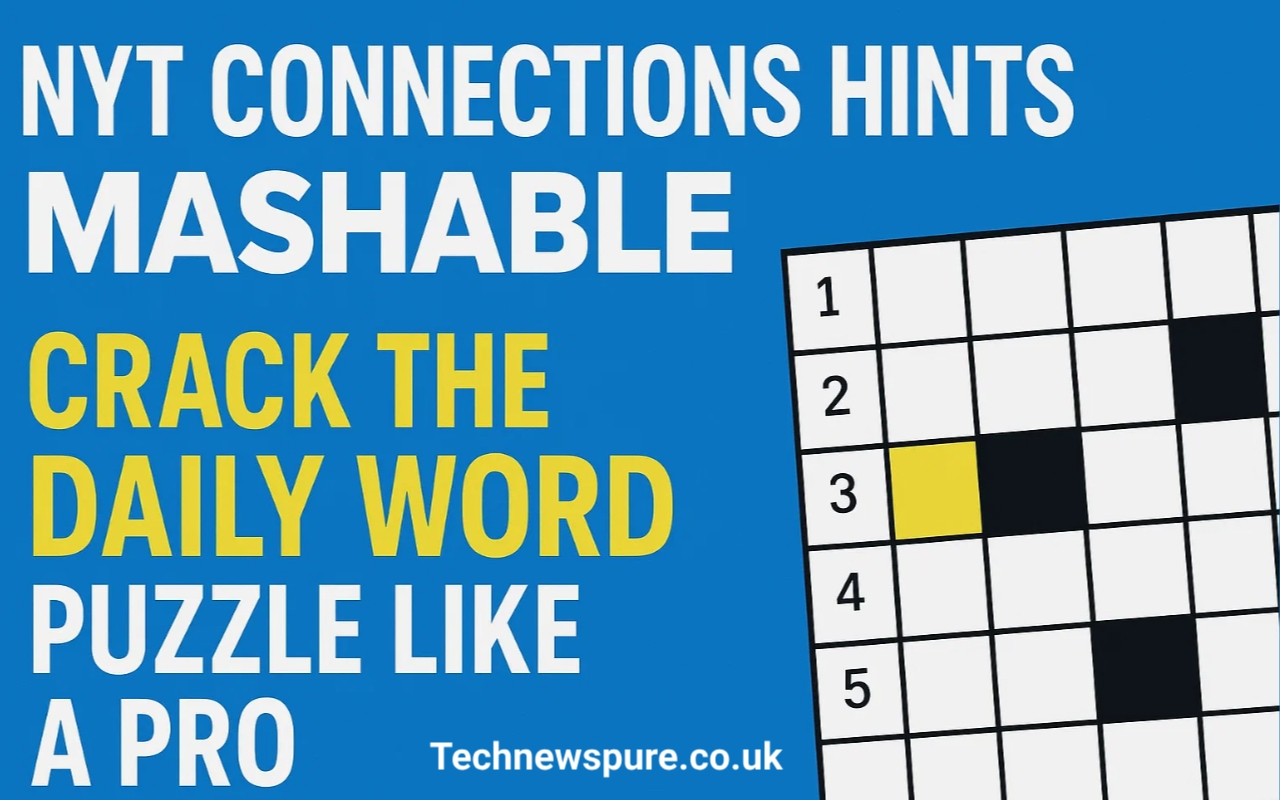Introduction
The world of digital puzzles has exploded in popularity thanks to the rise of daily brain teasers like Wordle, Spelling Bee, and more recently, NYT Connections. For those seeking a clever way to stretch their mental muscles every morning, NYT Connections offers an exciting blend of word association, logic, and a dash of lateral thinking. But here’s the twist—what happens when you’re one word short or stuck on that final, elusive category? That’s where the growing trend of NYT Connections hints Mashable comes into play. This comprehensive guide explores everything you need to know about leveraging Mashable’s hints to solve Connections puzzles faster, smarter, and without losing the thrill of the challenge.
What Is NYT Connections and Why It’s Trending
Launched by The New York Times, NYT Connections is a unique word puzzle that deviates from the single-word guessing style of Wordle. Instead, it presents players with a grid of 16 words. Your mission? To group these words into four sets of four, each based on a shared category or theme. These categories could range from the obvious—like colors or musical genres—to the obscure, including anagrams, puns, or conceptual links. This layered complexity is what makes Connections so engaging and, at times, deeply frustrating.
In an era where digital media competes for your attention span, Connections offers a refreshing change—a minimalist interface with a maximum brain workout. And because it updates daily, the sense of novelty never fades. However, with increased difficulty, especially on “purple category” days, many players seek subtle assistance without ruining the experience. Enter: NYT Connections hints from Mashable.
Understanding the Growing Demand for Puzzle Hints
Let’s be real—no one likes being stumped. Whether you’re a casual solver or a puzzle fanatic, hitting a wall can feel like running into quicksand. The frustration builds, especially when you’re sure two words belong together, but the game rejects your grouping. That’s where hints come in. Not full spoilers—just clever nudges that restore momentum. Mashable realized this very human need and built a system that respects your intelligence while offering guidance when you feel stuck.
Unlike other hint platforms that dump full solutions in your face, Mashable introduced tiered hints. Think of it as someone whispering the first letter of a crossword clue rather than filling in the whole word for you. This concept struck a chord with players who want to maintain a sense of accomplishment while still appreciating a little support along the way.
The Magic Behind NYT Connections Hints Mashable
So what makes Mashable’s hints for NYT Connections so unique? For starters, their hints don’t rob you of the fun—they amplify it. The editorial team breaks each daily puzzle into levels of assistance. The first level offers only a slight thematic nudge. The second gives a clearer directional push without revealing word groupings. And the third? It unveils the categories themselves if you’re completely lost and just want to know what the puzzle makers were thinking.
This gradual revelation system puts the power in your hands. Want just a spark to reignite your reasoning? Stick to level one. Need more clarity? Go to level two. Want to move on with your day and check your answers? Dive into level three. No guilt, no shame—just flexible support for every type of player. Mashable’s approach is both respectful and empowering, striking a rare balance in the world of puzzle help.
A Deep Dive into NYT Connections Puzzle Mechanics
Let’s break down the game itself to better understand why Mashable’s hints matter. In NYT Connections, the 16 words are randomized and unrelated at first glance. As you tap into your memory, creativity, and vocabulary, you begin identifying links. These links must be semantically or thematically coherent, but NYT doesn’t offer any initial guidance.
To complete the puzzle, you must correctly group four words into four separate categories, such as:
-
Birds: Falcon, Robin, Hawk, Sparrow
-
Types of Money: Euro, Dollar, Yen, Pound
-
Rhyming Words: Light, Kite, Sight, Bite
-
TV Shows from the 90s: Friends, Seinfeld, ER, X-Files
The game gets tricky when words could logically fit multiple themes. For instance, “Pound” could be a currency or a measurement. That’s where thoughtful hints like those from Mashable become invaluable.
What Do the Color Categories Mean in NYT Connections?
The puzzle uses a color-coded system to denote the difficulty of each category:
-
🟨 Yellow: The easiest and most obvious category. These are typically general knowledge or popular themes.
-
🟩 Green: Slightly more challenging. Categories may include lesser-known trivia or abstract groupings.
-
🟦 Blue: Difficult. Requires sharper observation, often involving wordplay or contextual reasoning.
-
🟪 Purple: The hardest. These are notorious for being deeply nuanced, often involving puns, multiple meanings, or unconventional associations.
Mashable tailors its hints accordingly, offering gentler guidance for yellow and green, and more structured support for blue and purple categories. This adaptability is one of its greatest assets.
How Mashable Organizes Its Puzzle Hints for Users
Every day, Mashable publishes a dedicated NYT Connections hints article. It’s usually divided into:
-
Today’s Puzzle Setup: A quick look at the grid layout.
-
Hint Level One: A soft suggestion like “Think colors” or “These words are all musical genres.”
-
Hint Level Two: A breakdown of category types without naming exact words.
-
Hint Level Three: The full answers if you decide you’re done guessing and want confirmation.
This structure lets users decide how much support they need. It’s like having a wise friend whispering, “You’re on the right track,” without doing the homework for you.
Step-by-Step Process: Using NYT Connections Hints on Mashable
Using these hints is simple but powerful. First, read the grid and try to identify obvious groups. If nothing clicks, read Hint Level One on Mashable. Still stuck? Dive into Level Two for thematic context. Only if absolutely necessary, read Level Three to validate your attempts.
This step-by-step approach enhances learning. You start understanding how the puzzle creators think. You also build up your own recognition of common patterns—Mashable doesn’t just give you the fish, it teaches you how to fish for categories daily.
The Strategic Power of Tiered Hinting Systems
The genius of Mashable’s system lies in its progressive reveal. Unlike spoiler-heavy forums or Reddit threads that drop the answers upfront, Mashable gives players breathing room. You’re encouraged to engage with the puzzle, not just passively consume answers. This helps maintain the game’s integrity and your long-term growth as a puzzle solver.
Over time, this creates what educators call “scaffolded learning”—a process where guidance is gradually reduced as you gain skill. It’s a subtle but powerful method of cognitive development applied to your morning game ritual.
SEO and Keyword Insights Behind ‘NYT Connections Hints Mashable’
From an SEO perspective, this guide is strategically built around the primary keyword “nyt connections hints mashable” while integrating supporting phrases like “nyt puzzle tips,” “connections game answers,” “mashable daily hints,” and “how to solve nyt connections.” These LSI keywords (Latent Semantic Indexing) enhance the content’s contextual depth, ensuring it ranks well across variations in user search queries.
Additionally, placing the focus keyword in key areas—like the H1, H2 tags, meta description, and the first 100 words—ensures strong visibility for search engines.
Why Mashable’s Approach Works Better Than Full Spoilers
What sets Mashable apart is its respect for user agency. While many platforms are quick to reveal answers, Mashable understands that puzzle-solving is more than just outcome—it’s about the process, the thrill of the chase, and the satisfaction of epiphany. Their editorial voice is warm, helpful, and never condescending, which is why it resonates so well with both beginners and seasoned players.
The Psychology of Puzzle Solving and the Role of Hints
Solving puzzles stimulates the brain’s reward centers. Every time you find a correct group, dopamine is released. But repeated failure? That leads to disengagement. Well-timed hints like those from Mashable act as mental reset buttons, preventing frustration and helping you stay in the flow. They reduce cognitive load without diluting the joy of discovery.
Tips and Tricks from the NYT Connections Community
Some insider strategies include:
-
Look for compound words or rhyming patterns.
-
Use the “shuffle” button to reset your visual interpretation.
-
Write the words on paper—it often reveals hidden links.
-
Revisit failed guesses—they’re often useful eliminators.
Joining online communities like Reddit’s r/NYTConnections or reading Mashable comments can also give you a sense of trending themes or recurring traps.
Mobile Optimization: Solving Connections on the Go
Mashable’s hint articles are fully mobile-optimized, featuring:
-
Clean fonts and structure for small screens
-
Fast-loading, lightweight design
-
Accessible hints in a scroll-friendly format
This means you can quickly refer to them while on your lunch break or during your morning commute without frustration.
Final Thoughts: How to Master NYT Connections Daily
Read More: Technewspure.co.uk
The NYT Connections hints Mashable system isn’t just a tool—it’s a tutor. By balancing helpful nudges with gameplay integrity, it turns every player into a better puzzler. Whether you’re chasing a winning streak or just trying to finish your first game, these hints can elevate your experience.
So next time you hit a wall, don’t abandon the game—use the hints wisely, learn from the categories, and return stronger the next day.

